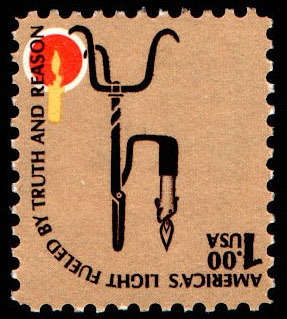CIA invert facts for kids
Quick facts for kids CIA invert |
|
|---|---|
 |
|
| Country of production | United States |
| Date of production | 2 July 1979 |
| Nature of rarity | Invert error |
| No. in existence | 100 |
| Face value | US $1.00 |
| Estimated value | US $15,000 |
The CIA invert is a very special one-dollar postage stamp from the United States Postal Service. It's called an "invert" because part of its design was printed upside down by mistake! This stamp is part of the Americana series that came out between 1975 and 1981.
The $1 stamp shows a colonial rushlight holder, which was an old-fashioned lamp. It was first released on July 2, 1979. A whole sheet of 100 stamps was printed with the dark brown part (the lamp's flame) upside down. This means the flame is inverted compared to the lamp holder and the words on the stamp.
About 95 of these rare stamps are known to exist today. The official number for this stamp in stamp collector books (called the Scott catalogue) is 1610c. This was the first time a major design element on a U.S. stamp was printed upside down since the Dag Hammarskjöld invert error in 1962.
Contents
The Amazing CIA Invert Stamp
This special stamp is famous because of how it was found and what happened afterward. It's a great example of how printing mistakes can make everyday items super valuable!
What is an Invert Stamp?
An "invert error" happens when a stamp is printed in multiple steps, and one of the printing plates is accidentally put into the machine upside down. For the CIA invert, the dark brown color, which shows the flame, was printed upside down. This makes the flame look like it's pointing down instead of up. These kinds of errors are very rare and exciting for stamp collectors.
How the CIA Invert Was Found
The only known sheet of these upside-down stamps was found in the spring of 1986. It had been sitting at a post office in McLean, Virginia, for quite some time. No one had noticed the mistake!
A Surprising Discovery
Five of the 100 stamps on the sheet had already been sold. The part of the sheet with the special plate number was also missing. An employee from the CIA bought the remaining stamps. They were buying stamps for the agency's mail.
At first, even the CIA employee didn't notice the upside-down flames. It was only a few days later that another CIA employee saw the error. This person needed a $1 stamp for an official mailing.
The Exchange
Once the error was discovered, this employee told eight co-workers. The nine of them decided they wanted to keep these rare stamps for themselves. They bought 95 regular $1 stamps. Then, they swapped these normal stamps for the rare "invert" stamps that belonged to the CIA.
After getting the stamps, they showed their find to a stamp dealer named Ike Snyder. He then connected them with Jacques C. Schiff, Jr., a stamp expert from New Jersey. Eventually, the group made a deal with Mr. Schiff. Each of the nine employees kept one inverted stamp. Mr. Schiff paid about $25,000 for the rest. He received a block of 85 stamps and one single stamp that was slightly damaged.
What Happened Next?
At first, Mr. Schiff tried to protect the group's privacy. He said that the 14 stamps not sold to him had been used on CIA mail. However, the real story soon came out in the news, reported by the New York Times and CBS.
Because of this, the stamp became known as the "CIA invert." The CIA had to investigate what happened. In the end, the CIA asked the nine employees to return their special stamps to the agency. They were told that if they didn't return the stamps, they would lose their jobs.
Four employees returned their stamps and kept working at the CIA. Four others refused to return their stamps and no longer worked there. The ninth employee claimed they had lost their stamp and continued to work for the CIA.
How Much is it Worth?
Even though the CIA invert is very rare, it's not as famous as some other error stamps. Stamp catalogs list its price at about $15,000. This is much less than the famous Inverted Jenny stamp, which is valued at $150,000. Both stamps have about the same number of copies known to exist.
A block of four CIA invert stamps was sold in 2004 for $60,000. Another block of four sold in 2015 for $71,875. Sometimes, copies of these stamps (not the real ones, but reproductions) have even been sold online.

